Bird song classifiers for Zürcher Oberland forests and at the Luppmen
Decision table for identifying birdsong
| Bird | Description | Audio |
| einfach rhythmisch | ||
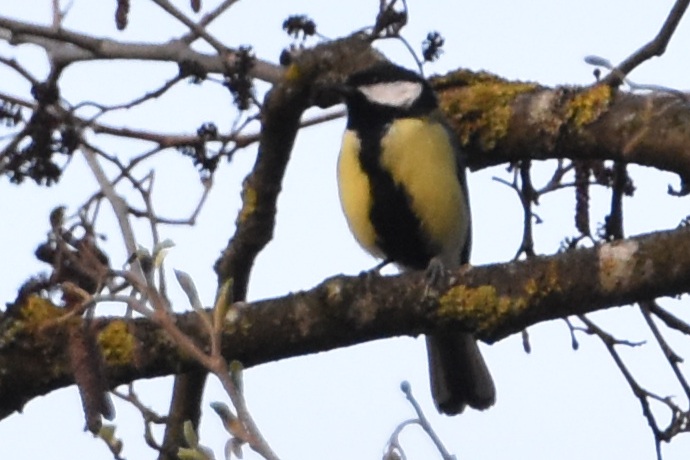 Kohlmeise ■■
Kohlmeise ■■ |
einfach rhythmisch slow medium (1-5 KHz) .
Said to have a repertoire as a species of 50 or more different songs, albeit simple ones, up to 10 per individual.
Females prefer a male with a large repertoire. One two-note song sounds like a squeaky bed.
Song: Nabu: Die erste Vogelart, die wir im Jahr hören, ist meistens die Kohlmeise mit ihrem typischen Läuten: "Zip Zäh" oder "Zip zip Zäh". [NABU Experte Lars Lachmann bei Deutschlandfunk Nova] | ♫ |
| Triller | ||
|
|
Triller einfach rhythmisch slow high (3-9 KHz) .
General: High-pitched, often descending (hhll), occasionally ascending. "Christina compares it to a ping-pong ball dropping. [In Januar singt die Kohlmeise als erster Vogel in Deutschland], dann kommt die Blaumeise dazu. Song: |
♫
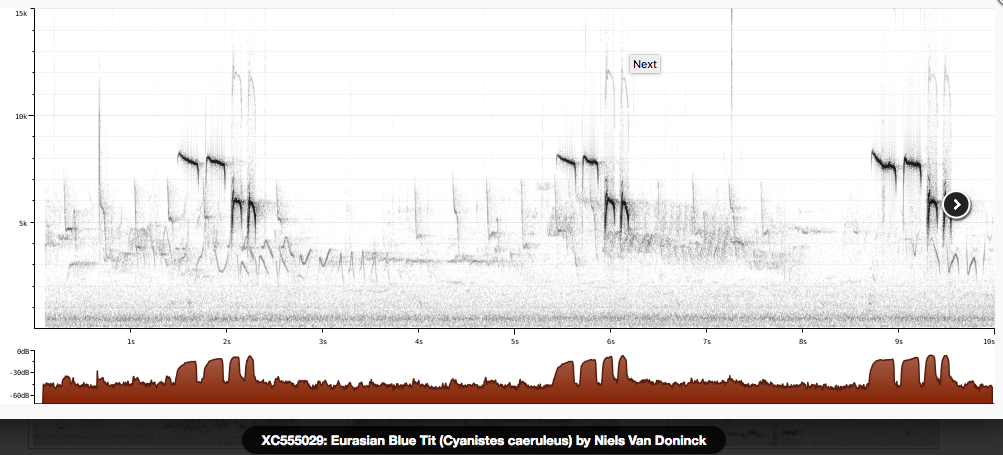
|
|
|
einfach rhythmisch fast low-high (2-10 KHz) .
Higher-pitched than great tit, sometimes repetitive 1- and 2-note tunes like them, sometimes simple melodies, usually pure, sometimes chirpy or raspy. BirdID at Nord U says 'Song: A simple one or two note call repeated in series. Usually rising slightly in pitch, and with a "liquid" quality.'. At bird-song.ch it's hl-rest-hl, or 7-8 2-noter swoops. bird-song.ch names lh-break-hl as a pistjä call and also has a series of 7 or 8 falling 'swoops'.
Song: Klapperlied - 6-8 Noten 'angeschlagen' |
♫

|
| stereotypisch melodisch | ||
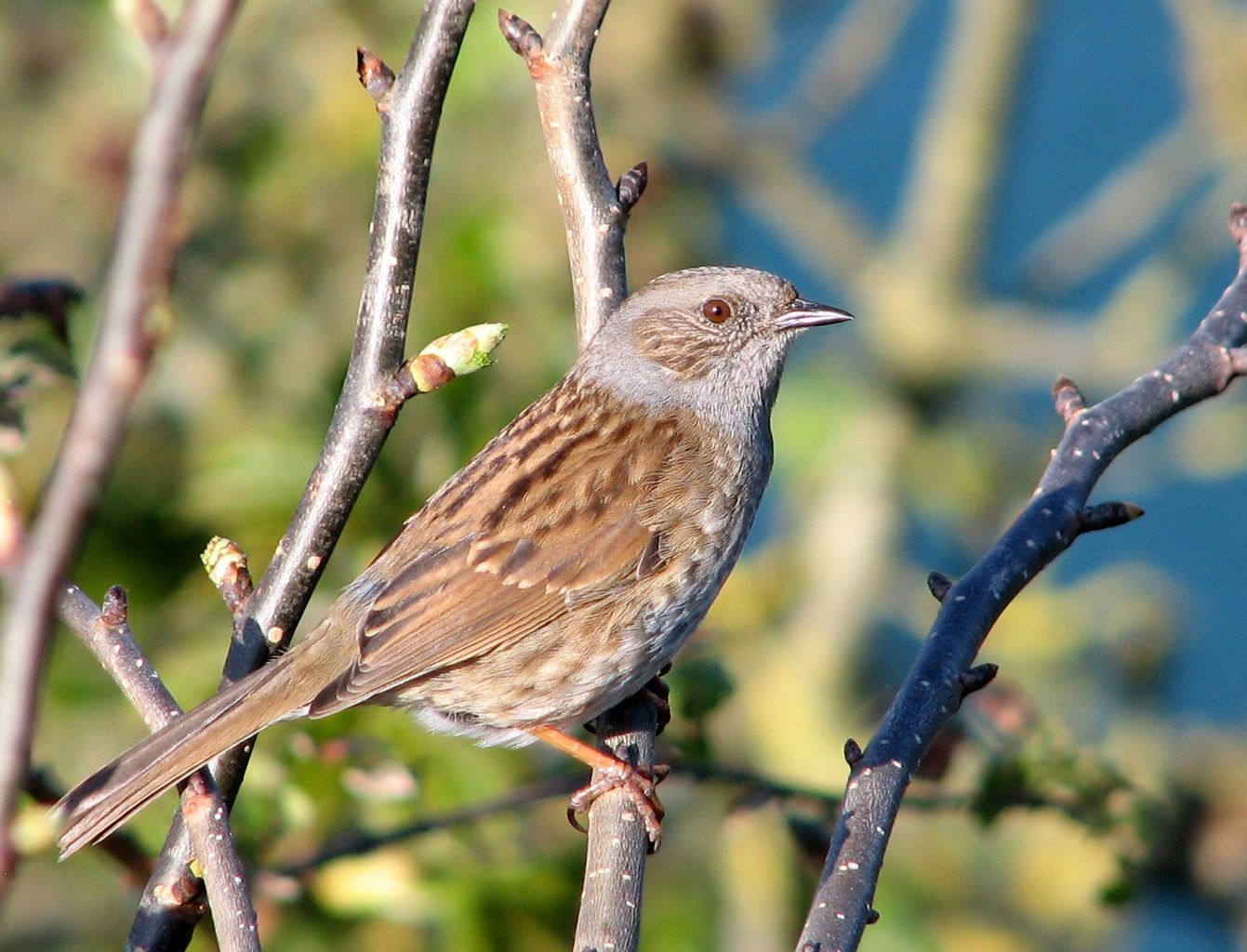 Heckenbraunelle ■■
Heckenbraunelle ■■ |
stereotypisch melodisch fast high (4-8 KHz) .
General: High-pitched, repetitive but complex little tune. Song: |
♫

|
| improvisiert melodisch | ||
| flöten | ||
|
|
flöten improvisiert melodisch fast high (3-9 KHz) .
General: Hoch aber auch bis tief, z.B. 2.9-7.7 KHz.
Wikipedia sagt, 'Der Gesang des Rotkehlchens ist mit 275 nachgewiesenen,
sich fortlaufend ändernden Motiven äußerst variabel.
[Ein einzelner Vogel lernt teilweise mehr als 30 verschiedene Strophen, sagteChristina Ebneter in BirdLife Feldornithologie-Kurs.]
Er wird mit vorgestreckter, das Rot betonender Brust, in der Regel von einer hohen Singwarte aus, vorgetragen. Er beginnt etwa eine Stunde vor Sonnenaufgang und ist noch eine gute Zeit nach Sonnenuntergang zu hören, hauptsächlich jedoch während der Dämmerung. Der Revieranzeigegesang wird normalerweise mit perlenden reinen Tönen und Trillern eingeleitet und fällt gegen Ende langsam ab; hohe metallische Töne werden oft dazwischen eingeschoben. Häufig sind in die 2,5 Sekunden langen Strophen auch undeutliche Imitationsphrasen eingelegt. Auf den Menschen wirkt der Reviergesang lieblich und schwermütig melodiös. Ist das Rotkehlchen hochgradig erregt, verdeutlicht es seinen Willen zur Eskalation durch übertönendes oder störendes Singen.' Ich habe in Ticino und Falera festgestellt, dass die Rotkehlchen immer noch singen und habe es nachher auch daheim im Zürcher Oberland gehört; das Ende des Singen Ende Juli ist anscheinend relativ. Seitdem weiss ich dass es eine der wenigen Vogelarten ist, die auch in Winter ein Territorium verteidigt...darum. Song: |
♫

|
| Triller | ||
|
|
Triller improvisiert melodisch fast high (3-9 KHz) .
High-pitched, melodic, very variable with many trills and whistles.
Song: | ♫ |
| stereotypisch melodisch | ||
| churr | ||
|
|
churr stereotypisch melodisch slow high (3-9 KHz) .
The song is two parts and unvarying. If it were a pop song, you'd call it ABABAB... The second part starts with a
sputtering trill. The RSPB in the UK says 'warble with crackling trills.' Vogelwarte.ch says
'Der gepresst knirschende Gesang setzt meist lange vor Sonnenaufgang ein und ist der Auftakt für das Vogelkonzert.'
BirdLife-Zuerich.ch says 'Einziger Sänger morgens um drei in den Häuserschluchten'.
Obwohl NABU.de meint, sie singen nicht mehr nach Juli, war ich angenehm überrascht sie in Oktober im Tessin zu hören.
Song: Other: Einige Arten wie der Hausrotschwanz singen zudem im Herbst, bevor sie in ihr Winterquartier ziehen. Die Männchen legen dann ihre Reviere bereits «provisorisch» fest. [Link] |
♫

|
| improvisiert melodisch | ||
| absteigend | ||
|
|
absteigend improvisiert melodisch slow low-high (2-9 KHz) .
Paced like a blackbird, humorous mix of elements like a nightingale. Huge range, elements from 2-5 KHz, others 6.5-9 KHz. Can sing for up to 50 minutes, and a male may know 100 melodies in its repertoire.
Song: | ♫ |
| nicht musikalisch | ||
| rasseln | ||
|
|
rasseln nicht musikalisch fast low-high (2-9 KHz) .
Song: |
♫

|
| stereotypisch melodisch | ||
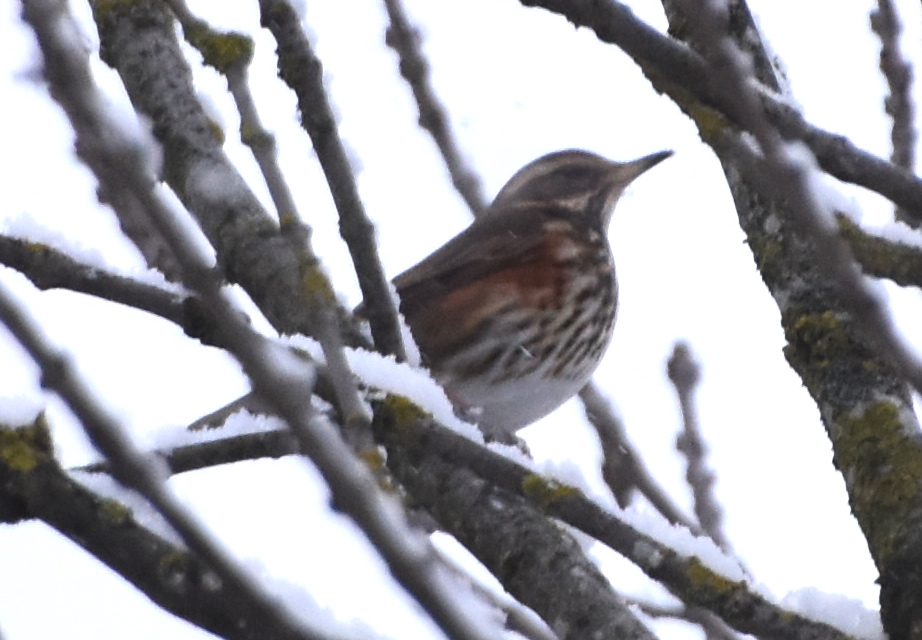 Rotdrossel down 6+chattering ■■
Rotdrossel down 6+chattering ■■ |
stereotypisch melodisch slow medium (3-5 KHz) .
|
♫

|
| einfach rhythmisch | ||
|
|
einfach rhythmisch slow high (3-9 KHz) .
Seems to consist of 3 notes repeated randomly, occasionally just 2 notes.
Though NABU.de says they stop singing at the end of July, I do hear their 3-note song occasionally in October,
but just one or two repetitions.
Song: | ♫ |
| stereotypisch melodisch | ||
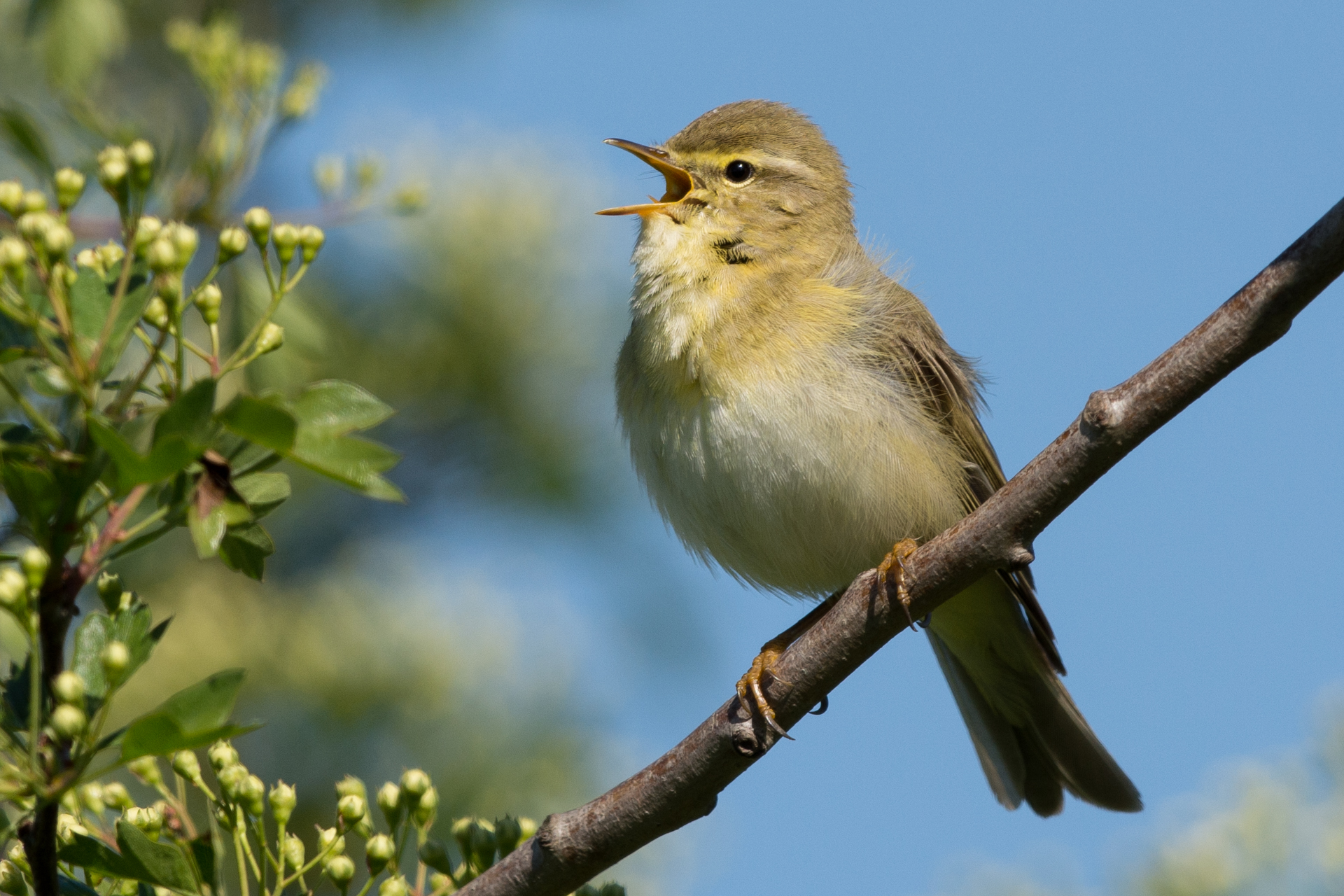 Fitis Buchfink diva ■■
Fitis Buchfink diva ■■ |
stereotypisch melodisch fast high (3-9 KHz) .
Gesang wie Buchfink aber höher, schnell, tendenz fallend aber mit mehr hoch und runter.
Song: |
♫

|
| improvisiert melodisch | ||
| Mimikry | ||
|
|
Mimikry improvisiert melodisch fast medium (2-5 KHz) .
They sometimes sing like a blackbird on speed - also non-stereotypic, seemingly improvised,
in short bursts.
Our local guy ends most of his songs with the same seven notes, which I find a good way to confirm the identification. In Ticino we often heard the 'Leiern' sound - the warblers would sing just the first 3 notes of a longer song, then stop. The order varied; high-medium-low I call 'Figaro' as in the opera, low-high-medium 'whiskey bar', as it sounded to me like the Kurt Weill lyrics, 'O-oh-show me-the-way to-the-next whis-ke-bar' - but the warbler usually stopped after 'way' or 'next' The British authors of The Sound Approach claim to hear 'a warblel and a whistle'.
Song: | ♫ |
| stereotypisch melodisch | ||
|
|
stereotypisch melodisch slow high (6-8 KHz) .
|
♫

|
| einfach rhythmisch | ||
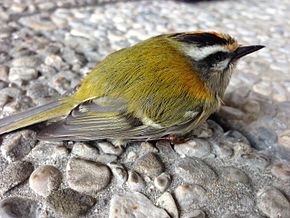 Sommergoldhähnchen ■■
Sommergoldhähnchen ■■ |
einfach rhythmisch fast high (6-8 KHz) .
Very high rhythmic repetition of about 3 seconds
Song: | ♫ |
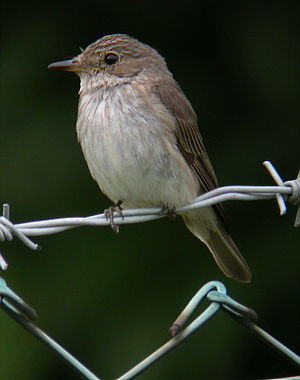 Grauschnäpper ■■
Grauschnäpper ■■ |
einfach rhythmisch slow high (6-8 KHz) .
High (6-8 KHz?) short sound repeated every half to 5 seconds.
Song: Gesang 'unauffaellig' - zirp x 2-3, mal steigender tWIT |
♫
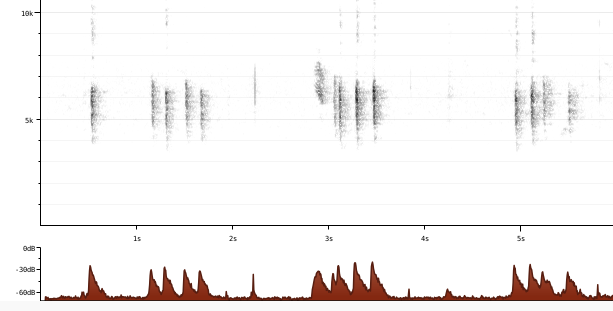
|
| einnotig | ||
|
|
einnotig fast medium (1-5 KHz) .
Song: Other: Song a simple series of loud notes. [Link] |
♫
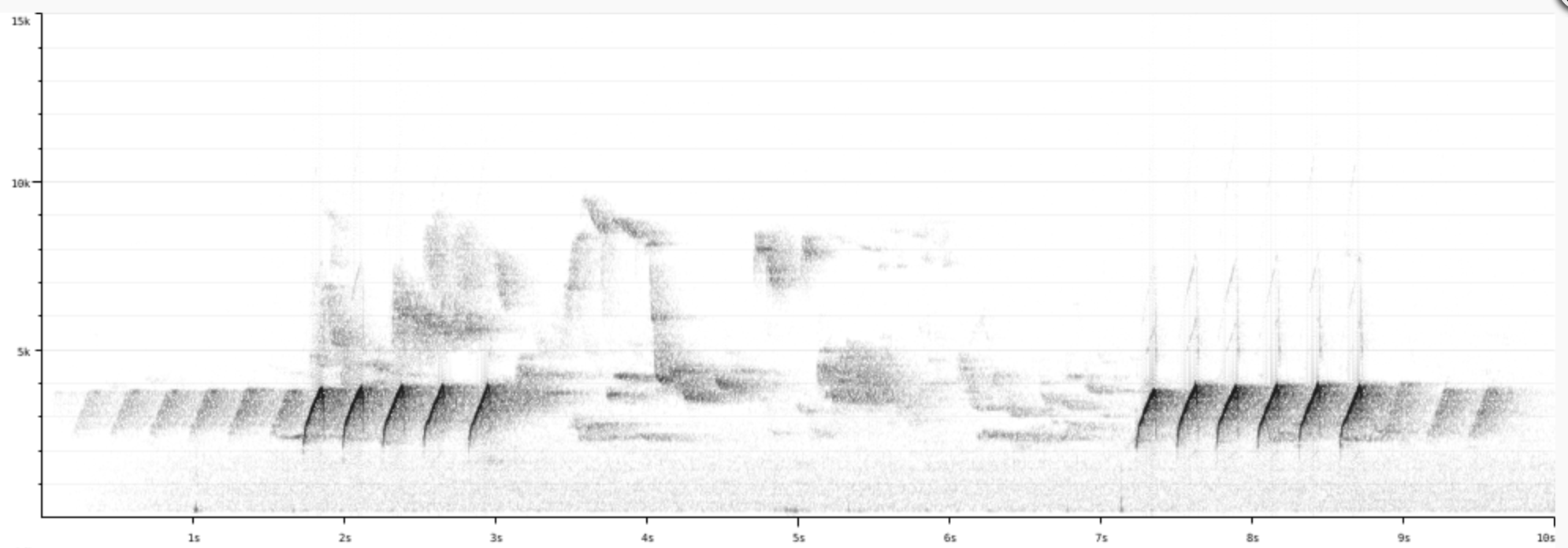
|
| stereotypisch melodisch | ||
|
|
stereotypisch melodisch slow high (4-7 KHz) .
General: It sounds to me like a 5-7 note song like 'five k low high higher', 'short song in the gar-DEN'. The individual notes have the same backward checkmark shape as the call. It's basically the same across Europe. Song: |
♫

|
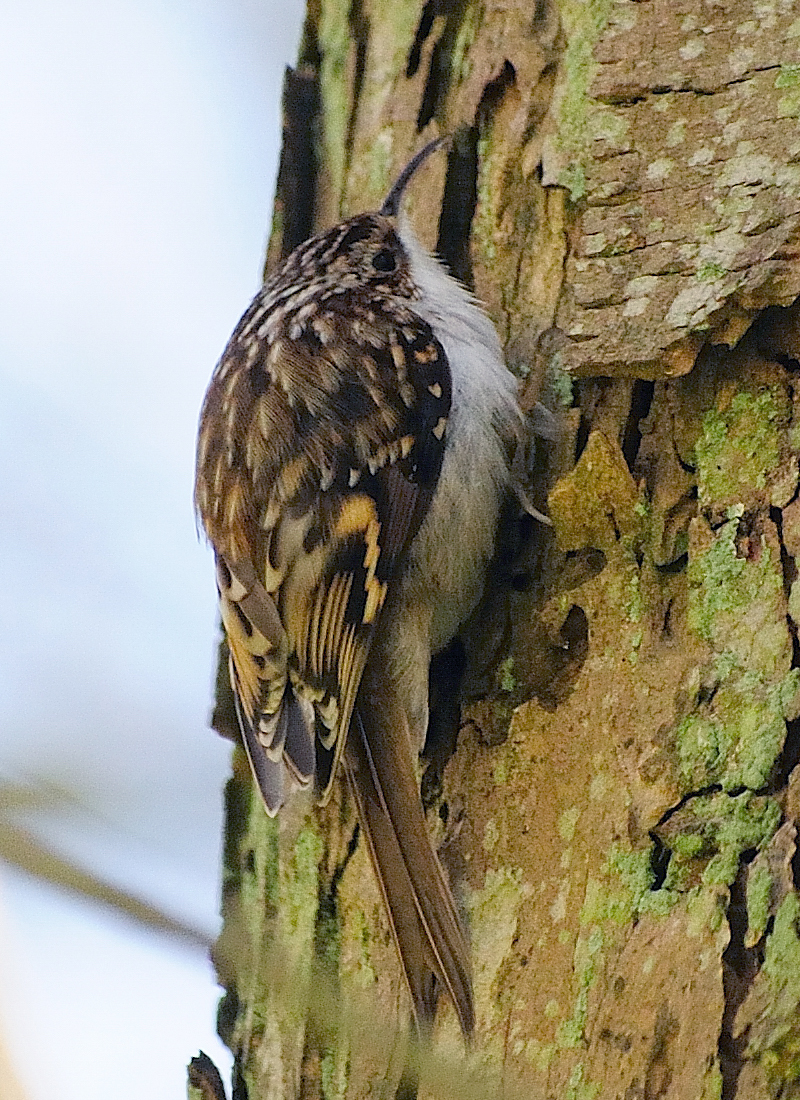 Waldbaumläufer Sagging tree branch ■■
Waldbaumläufer Sagging tree branch ■■ |
stereotypisch melodisch slow medium (1-5 KHz) .
Ich sage: es klingt wie ein schneller, hoher Buchfink. Wikipedia sagt: Die kurze Gesangsstrophe ist eine abfallende, zum Ende wieder ansteigende Reihe von leisen Pfeiftönen und erinnert an die Lautäußerungen von Blaumeise und Fitis. The example at bird-song.ch is a series of 5 notes falling 3x and rising back 2x, then 5 or so fast falling notes.
Song: |
♫

|
|
|
stereotypisch melodisch slow high (3-9 KHz) .
General: Meistens hoert man das Pfief...chk..chk..Pfief von den Rufen, siehe dort. Song: Nabu: Der Gesang ist ein feines Trillern und selten zu hören (someone at XenoCanto compares it to a blue tit trill). [Link] Song: Song: high tsee-tsee; funny downhill trill |
♫

|
| nicht musikalisch | ||
| Krächzen, Mimikry | ||
|
|
Krächzen, Mimikry nicht musikalisch fast medium (1-5 KHz) .
Harsh crow-like call, or quiet questioning, 'grumbling', or plaintive cries.
Song: |
♫
|
| stereotypisch melodisch | ||
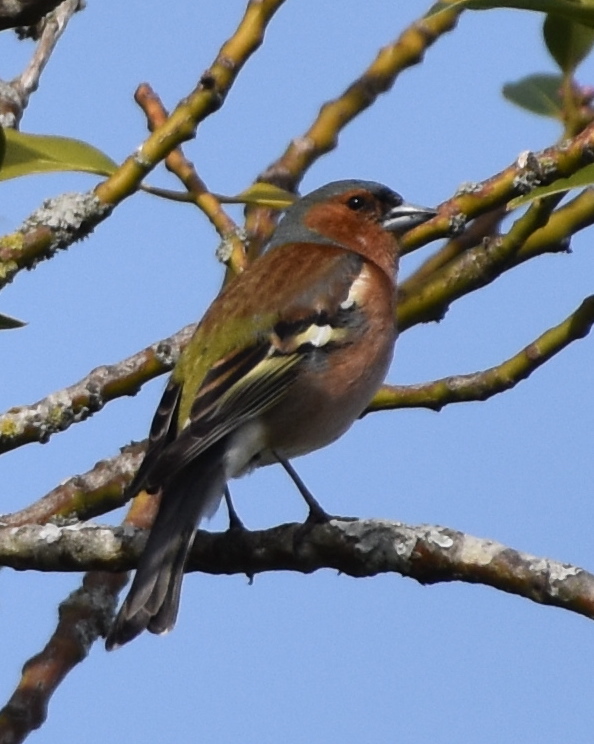 Buchfink ■■
Buchfink ■■ |
stereotypisch melodisch slow medium (1-5 KHz) .
General: A medium long phrase that slowly descends (I think of it bouncing down a staircase), then usually takes a
jump up before a final descent. Song: | ♫ |
| improvisiert melodisch | ||
| komisch, aufsteigend, Mimikry | ||
|
|
komisch, aufsteigend, Mimikry improvisiert melodisch slow medium (1-5 KHz) .
Ich find ihr Gesang lustig, wenn sie einzel sind. In Gruppen machen sie einen ziemlichen Lärm.
Song: | ♫ |
Uebung
♫ Lösung Kohlmeise ♫ Lösung
Waldbaumläufer XC656422 - Eurasian Treecreeper - Certhia familiaris - song, recorded in Sweden.
♫
Lösung
Waldbaumläufer XC656422 - Eurasian Treecreeper - Certhia familiaris - song, recorded in Sweden.
♫
 Lösung
Heckenbraunelle XC778759 - Dunnock - Prunella modularis - song recorded in Spain.
♫
Lösung
Heckenbraunelle XC778759 - Dunnock - Prunella modularis - song recorded in Spain.
♫
 Lösung
Kleiber Is the brevity what makes it a song, whereas calls seem to go on endlessly?
♫
Lösung
Singdrossel
♫
Lösung
Kleiber Is the brevity what makes it a song, whereas calls seem to go on endlessly?
♫
Lösung
Singdrossel
♫
 Lösung
Schwanzmeise
♫
Lösung
Zilpzalp
♫
Lösung
Schwanzmeise
♫
Lösung
Zilpzalp
♫
 Lösung
Rotkehlchen XC782997 - European Robin - Erithacus rubecula - song recorded in Italy.
♫
Lösung
Rotkehlchen XC782997 - European Robin - Erithacus rubecula - song recorded in Italy.
♫
 Lösung
Sumpfmeise
♫
Lösung
Zaunkönig XC554714-Zaunkoenig song.
♫
Lösung
Sumpfmeise
♫
Lösung
Zaunkönig XC554714-Zaunkoenig song.
♫
 Lösung
Rotdrossel
♫
Lösung
Rotdrossel
♫
 Lösung
Blaumeise XC555029 blaumeise.
♫
Lösung
Mönchsgrasmücke
♫
Lösung
Blaumeise XC555029 blaumeise.
♫
Lösung
Mönchsgrasmücke
♫
 Lösung
Misteldrossel XC800869 - Mistle Thrush - Turdus viscivorus.
♫
Lösung
Misteldrossel XC800869 - Mistle Thrush - Turdus viscivorus.
♫
 Lösung
Wintergoldhähnchen XC475114-Regulus regulus - Goldcrest song.
♫
Lösung
Wintergoldhähnchen XC475114-Regulus regulus - Goldcrest song.
♫
 Lösung
Grauschnäpper XC656714 - Spotted Flycatcher - Muscicapa striata.
♫
Lösung
Grauschnäpper XC656714 - Spotted Flycatcher - Muscicapa striata.
♫
 Lösung
Gartenbaumläufer
♫
Lösung
Gartenbaumläufer
♫
 Lösung
Fitis XC556112-Fitis 1 Laubsänger 2 song.
♫
Lösung
Star
♫
Lösung
Sommergoldhähnchen Amsel, rabenkraehe, eventuell sommergoldhaehnchen.
♫
Lösung
Fitis XC556112-Fitis 1 Laubsänger 2 song.
♫
Lösung
Star
♫
Lösung
Sommergoldhähnchen Amsel, rabenkraehe, eventuell sommergoldhaehnchen.
♫
 Lösung
Hausrotschwanz XC745021 - Black Redstart - Phoenicurus ochruros - typical song recorded in Calabria, Italy.
♫
Lösung
Buchfink Wald amsel plus buchfink.
Lösung
Hausrotschwanz XC745021 - Black Redstart - Phoenicurus ochruros - typical song recorded in Calabria, Italy.
♫
Lösung
Buchfink Wald amsel plus buchfink.